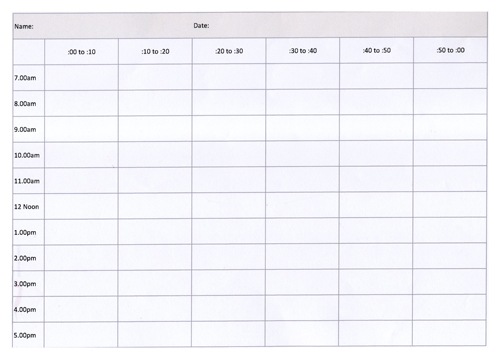

Call us now on: +44 161 819 9922

Business TrainingTraining for your future...

50 Years of Success
Established in 1974
"Helping you gain
.control of your career"
What is a Time Diary?
A time diary is a useful tool for showing you where your time is spent each day. It’s a detailed report of what activities you carry out, what time you do them and how long each activity takes you to complete. This includes all your activities, from the time you get up to when you go back to bed. You should note down every activity you do – not just those you consider to be work. So, include when you brushed your teeth, what time you had your lunch, what time you went to the supermarket, when you popped to the loo, what time you did the laundry and so on.
What is the Purpose of a Time Diary?
It’s used to help you improve efficiency so the time diary is designed to help you identify the:
- activities that take up most of your time
- most and least productive times of the day for you
- activities that can be combined to make more efficient use of your time.
If you are thorough when you complete your time diary, you’ll have a huge amount of important information to work with. You’ll be able to formulate a plan that allows you to work more efficiently, increase your productivity and reduce stress levels.
How to Keep a Time Diary
It’s not hard – all you need to do is note down when you start a task, when you finish it and what that task is. It should be kept for a minimum of seven consecutive days, although more would be better, as the longer you keep the diary for the more useful information you have to work with. You also need a record of anything you do at the weekends. This is important as often people end up working at the weekends to catch up on jobs that should have been done on weekdays.
Already there’s a chorus of ‘I don’t have time to keep a diary.’ But, in reality you have plenty of time – it only takes a moment to note down when you start and end an activity and you’ll only be doing it for seven days. Think of it this way – a little effort now can give you huge rewards in the future.
Complete the Time Diary as you go
Make sure you complete the time diary as you do the tasks. It’s no good getting to the end of the day and then trying to think about what you did at seven in the morning or when you had a cup of tea. You’ll inevitably miss things out and most probably miscalculate how long activities took you to complete.
How do I Create a Time Diary?
We’d advise creating time diary sheets that are quick and easy to fill in. The diary sheet should start at the time you get up and end at the time you go to bed. It’s useful to split the diary sheet into hourly segments and then each hour into 10 minute slots. So, your diary sheet should look something like this:

Obviously, you should change the layout of the diary sheet to fit your day. For example, if you get up at 5.30am you should start the diary from that time. Ten minute slots are sufficient to record the level of detail required to make this a useful exercise. Any more frequent and you’d be spending all your time filling in the form, any less frequent and the diary would not contain enough detail.
You can do this on paper or, if you have one of the more recent electronic gadgets, you could set it up electronically. Either way, once complete, your time diary will allow you to change the way you work to your advantage.
If you would like to learn how to manage your time better request a copy of our Effective Time Management – Making Life less Stressful course prospectus.





